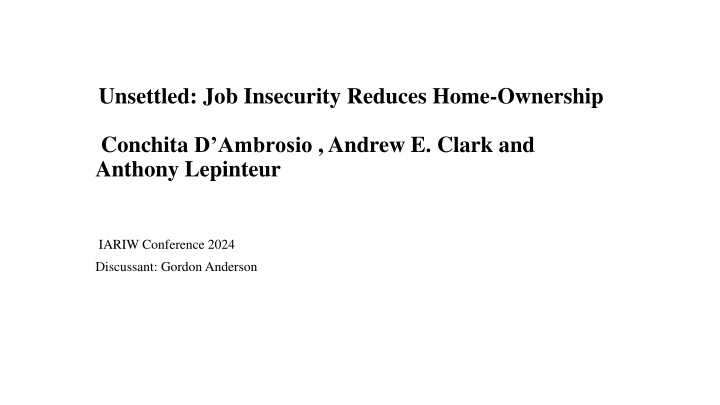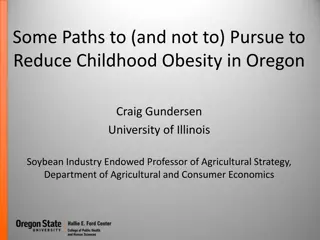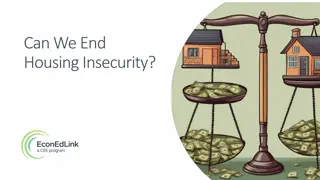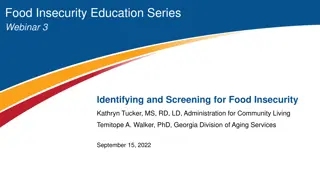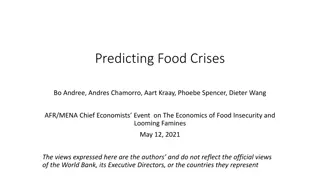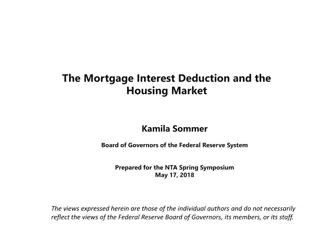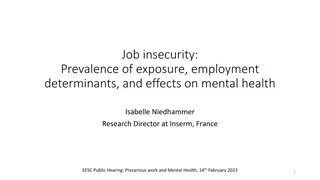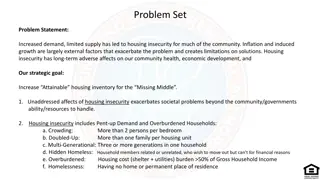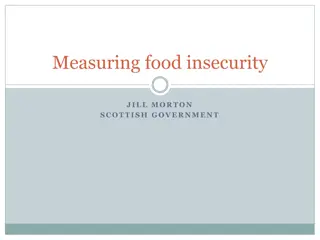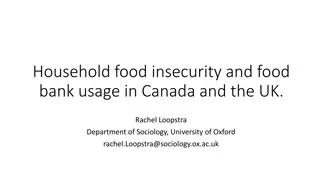Job Insecurity and Homeownership: A Study on Economic Challenges
Economic insecurity poses a significant challenge, with job insecurity impacting homeownership rates. Using a classic difference-in-differences analysis, this study explores the link between job insecurity and becoming a homeowner. Data from the European Community Household Panel is utilized to evaluate the effects of a tax reform on job security and home ownership decisions.
Download Presentation

Please find below an Image/Link to download the presentation.
The content on the website is provided AS IS for your information and personal use only. It may not be sold, licensed, or shared on other websites without obtaining consent from the author.If you encounter any issues during the download, it is possible that the publisher has removed the file from their server.
You are allowed to download the files provided on this website for personal or commercial use, subject to the condition that they are used lawfully. All files are the property of their respective owners.
The content on the website is provided AS IS for your information and personal use only. It may not be sold, licensed, or shared on other websites without obtaining consent from the author.
E N D
Presentation Transcript
Unsettled: Job Insecurity Reduces Home-Ownership Conchita D Ambrosio , Andrew E. Clark and Anthony Lepinteur IARIW Conference 2024 Discussant: Gordon Anderson
The Basic Story. Economic insecurity presents a major economic challenge (Blanchard and Tirole 2022) and has become the focus of much academic and public discourse. The authors have featured prominently in its study (Clark 2024, Clark, D Ambrosio, and Lepinteur 2023a, 2023b Rohde, D Ambrosio and Watson 2022). An interesting question is identifying sources of insecurity, is it engendered by perceptions and preferences or changes in the real constraints they face? The authors employ a classic difference-in-differences analysis to evaluate the link between job insecurity and homeownership. The results indicate that the greater job insecurity significantly reduced the probability of becoming a homeowner which was more attributable to individual preferences rather than greater capital constraints.
The Background Panel data from the European Community Household Panel is employed to exploit a 1999 increase in taxes on firms for laying off older workers in France which potentially precipitated an unexpected exogenous rise in job insecurity for younger workers. The Tax reform: Since its inception in 1987, the Delalande Tax Reform taxed firms for laying off older workers. In January 1999, a tax increase was introduced, but only for larger firms (those with 50 or more employees). This increase was publicly announced by the government in 1998. Home Ownership: The homeownership rate was on the upswing in the latter stages of the last century, the characteristics of new homeowners changed: while mortgages were the primary route to homeownership, the proportion of first-time buyers receiving financial support from their parents rose. First-time buying also became more unequal, with an increasing gradient between household income and the likelihood of becoming a homeowner.
The Empirical Strategy. The Classic Difference in Difference OLS Regression model. ???= ???????? ?????+ ?????+ ??+ ??+ ??? ???is a 1 is a 1- -6 ordered categorical variable reflecting 6 ordered categorical variable reflecting the subjective job security of worker i in year t (or a dummy for becoming a homeowner between the years t-1 and t.) With there being no change in the tax for smaller firms ??????is the treatment dummy, which is one for younger workers in firms with 50+ employees (the treatment group) and zero for those in smaller firms (the control group) ?????is a dummy for observations after January 1999 (the date of the Delalande tax rise). Equation (1) includes year dummies, ??, and a vector of standard individual socio- demographic controls ???. In specifications without the individual fixed effect, ??, these controls are gender, weekly working hours, monthly wages (in logs), the (lagged) number of children, and dummies for post-Secondary education, age (in 5-year bands), marriage, occupation and region; with the individual fixed effect, the gender and education information is dropped because of lack of variation. ??reveals the effect of the 1999 reform on both job security and homeownership decisions.
The Results Table 3: The 1999 Change in the Delalande Tax and Subjective Job Security - Pooled and Panel Results Subjective Job Security (std) (1) (2) (3) (4) Treat*Post -0.152*** -0.152*** -0.149*** -0.156*** (0.042) (0.042) (0.041) (0.039) Time-invariant characteristics . . Time-varying characteristics . . Individual FE Universally reduced Job Security across all specifications. . . .
The Results continued Table 4: The 1999 Change in the Delalande Tax and the Probability of Becoming a Homeowner - Pooled and Panel Results P(Became Homeowner) (1) (2) (3) (4) (5) Treat*Post -0.016* -0.016* -0.015* -0.020** 0.009 (0.009) (0.008) (0.008) (0.009) (0.030) Time-invariant characteristics . . . Time-varying characteristics . . Individual FE . . . Job insecurity More-or-less reduced the chance of becoming a home owner. . . . .
Results Continued. Table 5: The 1999 Change in the Delalande Tax and the Probability of Becoming a Homeowner Preferences or Constraints? Panel Results P(Became Homeowner) (1) (2) (3) (4) (5) Treat*Post -0.016 -0.024** -0.013 -0.020** -0.024** (0.012) (0.012) (0.011) (0.009) (0.010) Interacted with: Capacity to save at the end of the month: Yes -0.005 (0.017) Partner with a stable job 0.008 (0.015) Above median household income -0.016 (0.015) Recently received a gift, inheritance or windfall gain -0.025 (0.079) Favourable time for large purchases: Yes 0.028 (0.022) SpecificAgent characteristic effects observed.
Discussion: Dif-difmodel using ordered categorical data face 2 critiques. Bond and Lang (2019): Ordered categorical data suffers from the scaling problem, using the numbers 1 6 in regressions as cardinally comparable numbers is arbitrary and bereft of meaning(is level 4 really twice as good as level 2, why start at 1 and go to 6?) and different perfectly legitimate scales can and do engender substantially different results. Differences based upon different scales are thus also not comparable. Carniero, Heckman, Hansen (2002, 2003): Dif Dif models only concern themselves with differences in conditional means which is not a sufficient statistic for differences in the whole distribution (variation of the distribution could change substantially without altering the mean). The question being asked is did the policy change really negatively affect the subjective job security distribution of the treated group relative to the untreated group and was it attributable to the policy change? Should we be concerned with Average Security or Most Likely Security?
A Tale of two Distributions and what is going on within them. Figure 2: f(Y) The Distribution of being a home buyer ?(?)=?1, ?2, Figure 1: ?(?) The Distribution of Subjective Job Security (?(?) = ?1,?2,?3,?4,?5,?6) 1.2 1 0.8 0.6 0.4 0.2 0 probability not buyer buyer
A proposed solution. In the present contexts Y is an integer (? = ? for ? = 1,..,6 in the Job Security case and ? = 0,1 in the house buyer case). Think of the distribution ?(?) as a mixture of 4 distributions ??? ? = 1,..,4 so that ? ? = ?=1 ????? where ?=1 ??= 1 ??? ?? 0 ? = 1 agents in large firm after the tax rise with population proportion ?1 ? = 2 agents in small firm after the tax rise with population proportion ?2 ? = 3 agents in large firm before the tax rise with population proportion ?3 ? = 4 agents in small firm before the tax rise with population proportion ?4 The ???? = 1,..,6 (or ? = 0,1) can be computed from the data (??? is the proportion of respondents in group i reporting ?) as can the corresponding CDF s ??? = ?=1 Survival Functions ??? = 1 ??? . Replace an agents Y by its ??? , ??? or ??? as needed and work with those constructs. Provides a common metric (probability) across studies with different numbers of security outcome levels also works well in multidimensional frameworks. 4 4 ? ??? and
Interpretations. Not that different from the Cardinal Paradigm where the mean ? can be shown to be ? = ?? ? ?? = ? ? ?? with the interpretation of the cumulated chances of higher values of x. So that ?=1 average chance of a better outcome than Y in group i. Compare the CDF s ??? (the chance that an agent in group i has the same or inferior job security as the agent with Y) and the Survival Functions ??? (the chance that an agent in group i has job security that is superior to the agent with Y). The distributional changes question can be answered by considering the stochastic dominance relationship between ?1? and the other distributions, specifically is ?1? stochastically dominated by ??? ? = 2,3,4? (For which use the ??? ). 6 ??? /6 is the
References Blanchard, O., and Tirole, J. (2021). Major future economic challenges. France Strat gie. Bond T.N. and K. Lang (2019) "The Sad Truth about Happiness Scales," Journal of Political Economy 127, no. 4: 1629-1640 Carneiro, P., K. T. Hansen and J. J. Heckman (2002) Removing the Veil of Ignorance in Assessing the Distributional Impacts of Social Policy. NBER Working Paper 884 Carneiro, P., K. T. Hansen and J. J. Heckman (2003) 2001 Lawrence R. Klein Lecture Estimating Distributions of Treatment Effects with an Application to the Returns to Schooling and Measurement of the Effects of Uncertainty on College Choice. International Economic Review 44 361-422 Clark, A. E. (2024). Insecurity on the Labour Market. Review of Income and Wealth, forthcoming. https://doi.org/10.1111/roiw.12664 Clark, A. E., D Ambrosio, C., and Lepinteur, A. (2023a). Marriage as insurance: job protection and job insecurity in France. Review of Economics of the Household, 21, 1157-1190. Clark, A. E., D Ambrosio, C., and Lepinteur, A. (2023b). Job insecurity, savings and consumption: an Italian experiment, Mimeo, University of Luxembourg Clark, A. E., and Lepinteur, A. (2022). A natural experiment on job insecurity and fertility in France. Review of Economics and Statistics, 104, 386-398. Rohde, N., D Ambrosio, C., and Watson, B. (2022). Empirical Methods for Modelling Economic Insecurity. In Advances in Economic Measurement: A Volume in Honour of DS Prasada Rao, 265-306. Singapore: Springer Nature Singapore
